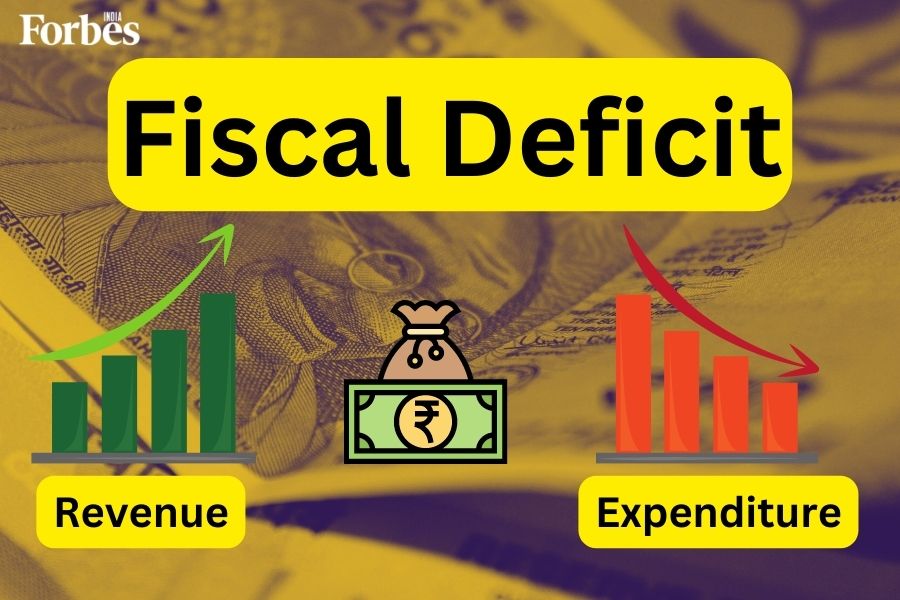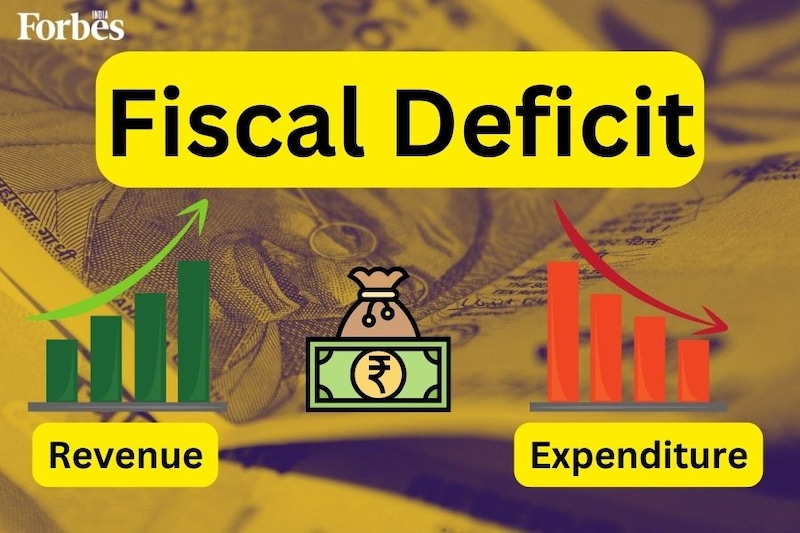
The fiscal deficit is one of the most important concepts in the dense lexicon of economics. Debates and policy decisions on the budget deficit are common because of the influence it has on a country’s economic growth and stability. If you’re interested in economics, or if you’re a concerned citizen, or especially if you’re a policymaker, knowing what the budget deficit is and why it matters is essential.In this article, we’ll start untangling the knots of fiscal deficit to see what it all means. We’ll look back at how India has dealt with this economic problem in the past. We will also understand the many facets of fiscal deficit, from the causes of its expansion to the methods used to reduce it and its consequences for the economy.
What is the fiscal deficit?
Fiscal deficit refers to the amount by which a government’s spending exceeds its revenue in a given fiscal year, leading to increased borrowing and accumulation of debt. It represents the amount of borrowing required by the government to meet its spending obligations when its expenses surpass its income.
When a government spends more than it generates through sources like taxes, fees, and other revenue streams, it incurs a fiscal deficit. The deficit is typically financed through borrowing from various sources, such as issuing government bonds or seeking loans from domestic or international entities. Accumulated fiscal deficits contribute to a country’s overall public debt burden.
Fiscal deficits can occur due to several factors, including increased government spending, economic downturns, tax cuts, subsidies, or inefficient revenue collection.
Governments often employ deficit financing to stimulate economic growth, support social welfare programs, or address emergencies. However, prolonged and excessive deficits can lead to concerns about fiscal sustainability, inflation, and high-interest payments on the accumulated debt.
Also Read: GDP of India: Current and historical growth rate, India’s rank in the world
Managing the fiscal deficit is a critical aspect of fiscal policy, and governments strive to strike a balance between promoting economic growth and maintaining fiscal discipline. The aim is to keep the deficit at a sustainable level while ensuring that public debt remains manageable, allowing the government to meet its financial obligations and maintain economic stability in the long term.
Also Read: Unemployment rate in India (2008 to 2024): Current rate, historical trends and more
India’s current fiscal deficit
According to data released by the Controller General of Accounts (CGA), India’s fiscal deficit for the first quarter of FY25 stood at 8.1 percent, Rs1,35,712 crore in absolute terms. The deficit stood at 25.3 percent of the Budget Estimates in the corresponding period of the financial year 2023-24. In the release, CGA said the net tax revenue was Rs5,49,633 crore or 21.1 percent of the budget estimates for the current fiscal. It was 18.6 percent in the same period last year. Total expenses in the first quarter were at Rs9,69,909 crore or 20.4 percent.
At 5.63 percent, India’s fiscal deficit for FY24 was slightly better than the estimated 5.8 percent in the interim Union Budget. The deficit stood at Rs16.53 lakh crore in actual terms. India still retains its title as the fastest-growing major economy. The manufacturing and mining sectors have contributed to the growth numbers, beating government projections.
The net tax collection for FY24 reached Rs23.26 lakh crore, while expenses were at Rs44.42 lakh crore. The CGA report indicates a revenue deficit of 2.6 percent and an effective revenue deficit of 1.6 percent. Looking ahead to FY25, the government anticipates a fiscal deficit of 5.1 percent of the GDP, equivalent to Rs16.85 lakh crore.
India’s fiscal deficit: Historical data
When looking back at India’s history of fiscal deficit, we see lots of ups and downs. Let’s take a brief look:
| Financial Year | Fiscal Deficit |
|---|---|
| 2013-14 | 4.50% |
| 2014-15 | 4.10% |
| 2015-16 | 3.90% |
| 2016-17 | 3.50% |
| 2017-18 | 3.50% |
| 2018-19 | 3.40% |
| 2019-20 | 4.60% |
| 2020-21 | 9.20% |
| 2021-22 | 6.80% |
| 2022-23 | 6.40% |
| 2023-24 | 5.80% |
| 2024-25 (Q1) | 8.10% |
Also Read: 1 USD to INR: From 1947 to 2024
| Period | Fiscal Deficit Overview |
|---|---|
| 1947-1970s | Relatively modest fiscal deficits characterised this period, showcasing cautious spending. |
| 1980s | Fiscal deficits increased due to rising expenditures, notably subsidies and welfare programs. |
| 1990s | Alarming levels of fiscal deficits led to a balance of payments crisis and triggered economic reforms. |
| Late 1990s – Early 2000s | Fiscal discipline improved, and deficits were contained within manageable levels. |
| 2008 Global Financial Crisis | Stimulus measures and increased spending widened the fiscal deficit in response to the economic slowdown. |
| Post-2008 | Efforts were made to reduce the deficit gradually, but challenges persisted, including subsidy burdens and weak tax revenues. |
| 2017 | Implementing the Goods and Services Tax (GST) aimed to enhance revenue collection. |
| 2020 COVID-19 Pandemic | Significant spending measures to support the economy led to a significant expansion of the fiscal deficit. |
Recent years have seen a continued emphasis on budgetary restraint. The Goods and Services Tax (GST) was introduced in 2017 to simplify indirect taxation and improve revenue collection. Non-performing asset problems have been targeted by laws like the Insolvency and Bankruptcy Code (IBC) that aim to strengthen fiscal viability.However, the 2020 COVID-19 pandemic has again had a significant effect on India’s budget.India’s history of budget deficits is a mix of fiscal consolidation and difficulties. Long-term fiscal sustainability and economic stability critically depend on continued efforts to rein down spending, boost revenue generation, and push for structural reforms.
Calculating Fiscal Deficit
The calculation of fiscal deficit is simple-
Fiscal deficit = Government Income – Government Expenditure
This can be elaborated upon for a clearer comprehension as follows:
Fiscal Deficit = (Revenue Expenditure + Capital Expenditure) – (Revenue Receipts + Capital Receipts Excluding Borrowings)
After some rearrangement of the phrases, we have,
Fiscal Deficit = (Revenue Expenditure – Revenue Receipts) + Capital Expenditure – (Recoveries of loans + other Receipts)
Let’s take the following example:
Let’s say the total expenditure is 500 crores and the total revenue is 400 crores, which implies,
Fiscal Deficit = 500 crores – 400 crores Fiscal Deficit = 100 crores
Therefore, the fiscal deficit, in this case, is 100 crores.
A budget deficit is an issue for many economies, including India. However, it’s important to remember that a country’s fiscal imbalance does not automatically indicate its economy is in bad shape.
A large budget deficit may be justified if the government invests heavily in long-term growth initiatives like the construction of highways, airports, and so on, or industries that will provide revenue in the years to come. Therefore, the revenue and spending portions must also be carefully examined while looking at the fiscal deficit statistic.
Also Read: India forex reserves 2024: Exploring current status and historical trends
What Causes Fiscal Deficit?
When a country’s expenditures surpass its revenues, this is known as a fiscal deficit. There is a wide range of possible causes for this:
- Increased Government Spending: If tax revenues don’t rise proportionately, a government’s increased spending on programs and initiatives could increase the deficit.
- Lower Revenue: Declining tax revenues or natural resource income are two examples of revenue decreases that might lead to a worsening deficit.
- Economic Downturns: An increase in the deficit is possible if government revenues fall while expenditures rise during a recession.
- War or Natural Disasters: The government may need to boost spending to deal with the aftermath of a war or a natural disaster, adding to the deficit.
- Social Welfare: The deficit of a country may increase if it has many costly social welfare programs.
- Interest on Debt: It’s possible that interest payments on a government’s debt may be large, adding even more to the deficit.
Conclusion
The fiscal imbalance in India remains a top priority for government officials and financial analysts. Although measures have been taken to lower the deficit, it remains a significant problem for the Indian economy still.Measures must be taken to cut wasteful spending and boost funding for crucial public programs. India can only achieve long-term economic growth and stability by taking a holistic strategy to address the fiscal imbalance.
Frequently Asked Questions
1. Why is the fiscal deficit a matter of concern in India?Fiscal deficit can be a major concern in India due to its potential economic impact: it can lead to increased government debt, higher interest payments, and a crowding-out effect on private investment. 2. What are the major factors contributing to India’s fiscal deficit? India’s fiscal deficit is influenced by various factors, such as government spending on subsidies, social welfare programs, infrastructure development, defence expenditure, and interest payments on previous borrowings. 3. What are the consequences of a high fiscal deficit in India? A high fiscal deficit can lead to increased government borrowing, which raises the rate of interest and reduces the availability of credit for private investment. This can hamper economic growth. Moreover, a large fiscal deficit can also put pressure on inflation rates, as excessive government spending may result in an increased money supply.
More updates on fiscal deficit
Jayant Sinha on fiscal roadmap, growth, PLI scheme, and policy reformsFiscal deficit: Will the gap remain higher for longer?The FY23 Budget fiscal math puzzle
